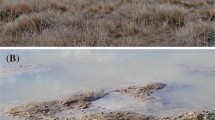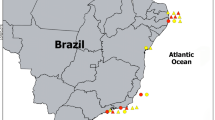Abstract
The amphioxi Branchiostoma belcheri, Branchiostoma japonicum and Branchiostoma malayanum are recorded from the coast of China Seas. Six amphioxus populations comprising three Branchiostoma species collected from Hong Kong (southern China), Xiamen (south-eastern China) and Qingdao (northern China) were compared at the morphological and molecular levels. Phylogenetic separations among the species and geographic populations were evaluated by the analysis of 12S ribosomal RNA gene sequences and amplified fragment length polymorphism (AFLP) markers. From morphological characters, B. belcheri is more closely related to B. japonicum than to B. malayanum. However, phylogenetic affinities indicated by both 12S rRNA gene sequences and AFLP analysis showed a more recent phylogenetic splitting of B. belcheri and B. malayanum than that of B. belcheri and B. japonicum. In the AFLP similarity tree, geographic populations of B. japonicum were clustered into different clades. The AFLP data also showed that both B. belcheri and B. japonicum populations in Hong Kong have the highest levels of within-population genetic diversity as compared to that in Xiamen and Qingdao, suggesting that genetic diversity of Branchiostoma decreases from low to high latitudes. Results of hierarchical analysis of molecular variance (AMOVA) also revealed a high level of genetic diversity either for the three B. japonicum populations or the two B. belcheri populations in China Seas. However, genetic variation among the three B. japonicum populations was insignificant, indicating that these populations are genetically connected.





Similar content being viewed by others
References
Amos W, Balmford A (2001) When does conservation genetics matter? Heredity 87:257–265
Avise JC, Bowen BW, Lamb T, Meylan AB, Bermingham E (1992) Mitochondrial DNA evolution at a turtle’s pace: evidence for low genetic variability and reduce microevolutionary rates in the Testudines. Mol Biol Evol 9:457–473
Bazin E, Glémin S, Galtier N (2006) Population size does not influence mitochondrial genetic diversity in animals. Science 312:570–572
Boring AM, Li HL (1932) Is the Chinese amphioxus a separate species? Peking Nat Hist Bull 6:9–17
Chin TG (1941) Studies on the biology of the Amoy amphioxus Branchiostoma belcheri Gray. Phil J Sci 75:369–424
Dice LR (1945) Measures of the amount of ecologic association between species, Ecology 26:297–302
Excoffier L, Smouse PE, Quattro JM (1992) Analysis of molecular variance inferred from metric distances among DNA haplotypes—application to human mitochondrial-DNA restriction data. Generics 131:479–491
Fang YQ (1987) Ecological habitats and conservation of amphioxus (in Chinese). Chin J Zool 22:41–45
Hamrick JL, Loveless MD (1989) The genetic structure of tropical tree populations: association with reproductive biology. In: Bock JH, Linhart YB (eds) Evolutionary ecology of plants. Westview Press, Boulder, pp 129–146
Henmi Y, Yamaguchi T (2003) Biology of the Amphioxus, Branchiostoma belcheri, in the Arike Sea, Japan I. Population structure and growth. Zool Sci 20:887–906
Kon T, Nohara M, Nishida M, Sterrer W, Nishikawa T (2006) Hidden ancient diversification in the circumtropical lancelet Asymmetron lucayanum complex. Mar Biol 149:875–883
Kumar S, Tamura K, Jakobsen IB, Nei M (2001) MEGA2: molecular evolutionary genetics analysis software. Bioinformatics 17:1244–1245
Lin XJ (2001) Systematic and ecological studies of amphioxus from the coastal areas of Taiwan, Kinmen and Matsu. Thesis for Master Degree, National Taiwan University
Mantel N (1967) The detection of disease clustering and a generalized regression approach. Cancer Res 27:209–220
Nei M (1973) Analysis of gene diversity in subdivided populations. Proc Natl Acad Sci USA 70:3321–3323
Nohara M, Nishida M, Manthacitra V, Nishikawa T (2004) Ancient phylogenetic separation between Pacific and Atlantic Cephalochordates as revealed by mitochondrial genome analysis. Zool Sci 21:203–210
Nohara M, Nishida M, Miya M, Nishikawa T (2005) Evolution of the mitochondrial genome in Cephalochordates as inferred from complete nucleotide sequences from two Epigonichthys species. J Mol Evol 60:526–537
Poss SG, Boschung HT (1996) Lancelets (Cephalochordata: Branchiostomatodae): how many species are valid? Israel J Zool 42(Suppl):S13–S66
Richardson BJ, McKenzie AM (1994) Taxonomy and distribution of Australian Cephalochordates (Chordata: Cephalochordata). Invertbr Taxon 8:1443–59
Schneider S, Roessli D, Excoffier L (2000) ARLEQUIN: a software for population genetics data analysis. Genetic and Biometry Laboratory, University of Geneva, Switzerland
Shin PKS, Huang ZG, Wu RSS (2004) An updated baseline of subtropical macrobenthic communities in Hong Kong. Mar Pollut Bull 49:128–135
Shu DG, Morris SC, Zhang XL (1996) A Pikaia-like chordate from the lower Cambrian of China. Nature 384:57–158
Spielman D, Brook BW, Frankham R (2004) Most species are not driven to extinction before genetic factors impact them. Proc Natl Acad Sci USA 101:15261–15264
Tchang S, Koo KC (1936) Description of new variety of Branchiostoma belcheri (Gray) from Kiaochow Bay, Shantung, China. Contr Inst Zool Natl Acad Peking 3:7–114
Thompson JD, Gibson T, Plewniak F, Jeanmougin F, Higgins DG (1997) The Clustal X windows interface: flexible strategies tools. Nucleic Acids Res 24:4876–4882
Vos P, Hogers R, Bleeker M, Reijans M, van de Lee T, Hornes M, Frijters A, Pot J, Peleman J, Kuiper M, Zabeau M (1995) AFLP: a new technique for DNA fingerprinting. Nucleic Acids Res 23:4407–4414
Wang YQ, Xu QS, Peng XX, Zhou HT (2004) Taxonomic status of amphioxus Branchiostoma belcheri in Xiamen beach estimated by homologous sequences of Cyt bgene. Acta Zool Sin 50:60–66
Xu QS, Ma F, Wang YQ (2005) Morphological and 12S rRNA gene comparison of two Branchiostoma species in Xiamen waters. J Exp Zool 304B:1–9
Zhang QJ, Zhong J, Fang SH, Wang YQ (2006) Branchiostoma japonicum and B. belcheri are distinct lancelets (Cephalochordata) in Xiamen waters in China. Zool Sci 23:573–579
Acknowledgments
This study was supported by the Environment Conservation Fund of Hong Kong SAR government (Project No. 3/2002). The authors would like to thank Professor Ke Caihuan from Xiamen University and Prof. Zhang Zhinan from Ocean University for their assistance in obtaining amphioxus samples from Xiamen and Qingdao, China.
Author information
Authors and Affiliations
Corresponding author
Additional information
Communicated by K. Yin.
Rights and permissions
About this article
Cite this article
Chen, Y., Cheung, S.G., Kong, R.Y.C. et al. Morphological and molecular comparisons of dominant amphioxus populations in the China Seas. Mar Biol 153, 189–198 (2007). https://doi.org/10.1007/s00227-007-0797-7
Received:
Accepted:
Published:
Issue Date:
DOI: https://doi.org/10.1007/s00227-007-0797-7




